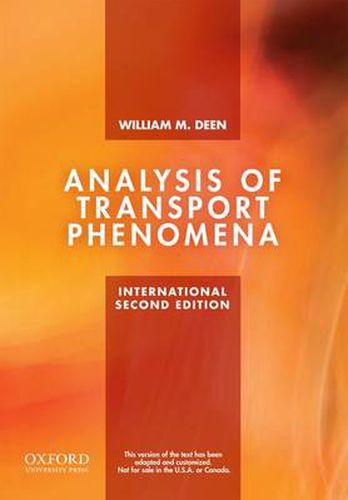Readings Newsletter
Become a Readings Member to make your shopping experience even easier.
Sign in or sign up for free!
You’re not far away from qualifying for FREE standard shipping within Australia
You’ve qualified for FREE standard shipping within Australia
The cart is loading…






Analysis of Transport Phenomena, International Second Edition, provides a unified treatment of momentum, heat, and mass transfer, emphasizing the concepts and analytical techniques that apply to these transport processes. The international second edition has been revised to reinforce the progression from simple to complex topics and to better introduce the applied mathematics that is needed both to understand classical results and to model novel systems. A common set of formulation, simplification, and solution methods is applied first to heat or mass transfer in stationary media and then to fluid mechanics, convective heat or mass transfer, and systems involving various kinds of coupled fluxes.FEATURES:* Explains classical methods and results, preparing students for engineering practice and more advanced study or research* Covers everything from heat and mass transfer in stationary media to fluid mechanics, free convection, and turbulence* Improved organization, including the establishment of a more integrative approach* Emphasizes concepts and analytical techniques that apply to all transport processes* Mathematical techniques are introduced more gradually to provide students with a better foundation for more complicated topics discussed in later chapters
$9.00 standard shipping within Australia
FREE standard shipping within Australia for orders over $100.00
Express & International shipping calculated at checkout
Analysis of Transport Phenomena, International Second Edition, provides a unified treatment of momentum, heat, and mass transfer, emphasizing the concepts and analytical techniques that apply to these transport processes. The international second edition has been revised to reinforce the progression from simple to complex topics and to better introduce the applied mathematics that is needed both to understand classical results and to model novel systems. A common set of formulation, simplification, and solution methods is applied first to heat or mass transfer in stationary media and then to fluid mechanics, convective heat or mass transfer, and systems involving various kinds of coupled fluxes.FEATURES:* Explains classical methods and results, preparing students for engineering practice and more advanced study or research* Covers everything from heat and mass transfer in stationary media to fluid mechanics, free convection, and turbulence* Improved organization, including the establishment of a more integrative approach* Emphasizes concepts and analytical techniques that apply to all transport processes* Mathematical techniques are introduced more gradually to provide students with a better foundation for more complicated topics discussed in later chapters